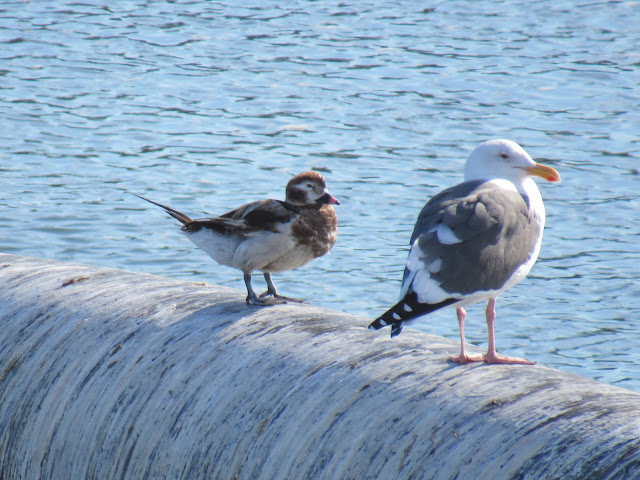The Long-tailed Duck of Moss Landing Harbor
Sea ducks of the far north, Long-tailed Ducks are not all that common along the coast of Central California. Nearing the southern extent of their winter range here, just a few individuals are spotted every winter along the coast, usually singly or mixed with flocks of other sea ducks, like scoters. According to eBird records, this particular Long-tailed Duck, which we encountered last Friday while birding along Moss Landing's Jetty Road, has been hanging out in Moss Landing Harbor since May, which is quite unusual.
Long-tailed Ducks breed in the Arctic, where they build their nests near the water's edge along ponds, streams and northern wetlands. Winters are spent on the open ocean or freshwater lakes; they are often found on northern bodies of water, like the Bering Sea, Hudson Bay, Puget Sound and the Great Lakes, favoring waters off of sandy shores.
Diving deeper than most other species of diving ducks, Long-tailed Ducks can reach depths of 200 feet while foraging, though most of their dives are within 30 feet of the surface. Cornell's All About Birds also indicates that when foraging, Long-tailed Ducks spend more time under water, relative to time at the surface, than any other diving duck. Prey, which is caught at or near the bottom, is largely aquatic invertebrates, such as insects, mollusks (mussels, clams and the like) and crustaceans.
Threats to these small sea ducks are many, and include oil spills and other ocean pollution, as well as entanglement in fishing nets. Their habit of staying together in large flocks far out at sea means that entire flocks may be killed at one time by oil contamination or as the result of becoming caught up in fishing nets.
I'm not entirely sure what the story is with the Long-tailed Duck of Moss Landing Harbor. I would call this bird an immature male, and over the last six months or so, various birders have noted a few different times that he hasn't looked very well. But since the molt cycle of Long-tailed Ducks is particularly complex, with a series of overlapping partial molts, maybe this guy has just had a rough molt! He was a delight to watch, and I hope that the calm, cold waters of Moss Landing Harbor serve him well until he's able to return to suitable breeding grounds in the spring.
Long-tailed Ducks breed in the Arctic, where they build their nests near the water's edge along ponds, streams and northern wetlands. Winters are spent on the open ocean or freshwater lakes; they are often found on northern bodies of water, like the Bering Sea, Hudson Bay, Puget Sound and the Great Lakes, favoring waters off of sandy shores.
Diving deeper than most other species of diving ducks, Long-tailed Ducks can reach depths of 200 feet while foraging, though most of their dives are within 30 feet of the surface. Cornell's All About Birds also indicates that when foraging, Long-tailed Ducks spend more time under water, relative to time at the surface, than any other diving duck. Prey, which is caught at or near the bottom, is largely aquatic invertebrates, such as insects, mollusks (mussels, clams and the like) and crustaceans.
In older field guides, Long-tailed Ducks are listed under their former name, "Oldsquaw," which of course has fallen out of favor in recent years due to its political incorrectness. Kaufman's book Lives of North American Birds notes that they were given this name for their tendency to be more vocal than other ducks, though it's the male ducks that make most of the noise!
Threats to these small sea ducks are many, and include oil spills and other ocean pollution, as well as entanglement in fishing nets. Their habit of staying together in large flocks far out at sea means that entire flocks may be killed at one time by oil contamination or as the result of becoming caught up in fishing nets.
I'm not entirely sure what the story is with the Long-tailed Duck of Moss Landing Harbor. I would call this bird an immature male, and over the last six months or so, various birders have noted a few different times that he hasn't looked very well. But since the molt cycle of Long-tailed Ducks is particularly complex, with a series of overlapping partial molts, maybe this guy has just had a rough molt! He was a delight to watch, and I hope that the calm, cold waters of Moss Landing Harbor serve him well until he's able to return to suitable breeding grounds in the spring.












Comments
Post a Comment